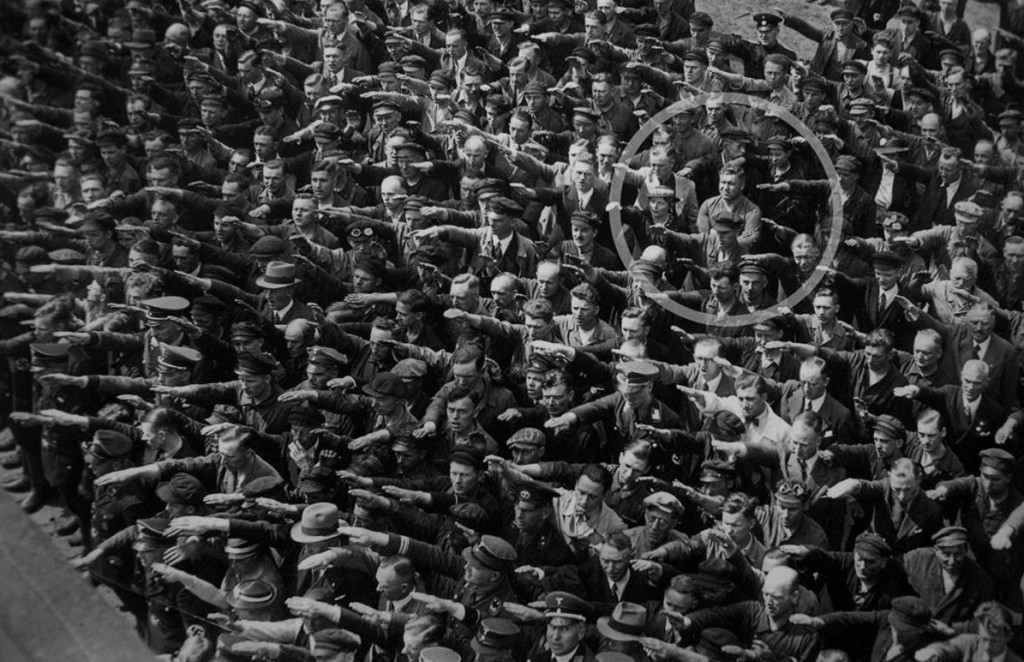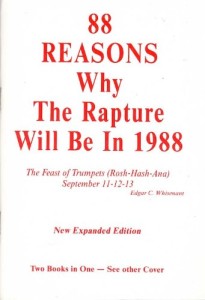
Being a Jesus Follower in a pagan culture means having the courage to be this guy (circled) every day.

Being a Jesus Follower in a pagan culture means having the courage to be this guy (circled) every day.
{Welcome to Cranky Blog Theater, I’m your host Geezer McCrotchety.}
“Stuff You Should Know,” hosted by Josh Clark and Chuck Bryant, is consistently one of the most widely downloaded podcasts on iTunes. I dialed up an episode while working out at the gym recently—an October episode titled “Vocal Fry and Other Speech Trends.”
I didn’t make it to the three-minute mark of the presentation before my eyes were rolling so hard they almost shot out of my head. I’ll explain why in a moment.
If you’re not familiar with the “vocal fry” trend, here’s a two minute introduction to the now ubiquitous affectation among younger women:
https://www.youtube.com/watch?v=YEqVgtLQ7qM
The “Other Speech Trends” mentioned in the title of the SYSK episode included something called “uptalking.” What is “uptalking” you ask? Read the previous sentence out loud and take note of how your inflection rises at the end of the sentence. When you’re an uptalker? You pretty much end every phrase? With a question-y inflection? Even when it’s not a question?
I’m hearing it everywhere these days. In fact, I work around enough younger people that I frequently hear it coming out of my own mouth. It’s infectious.
I’ve noticed several movies and sitcoms recently where they use excessive uptalking in a character as a device to quickly show the audience that this person is un-smart, shallow and a little ridiculous. It’s an effective device.
To be fair, uptalking can actually serve a function in communication. When a speaker ends with a questioning inflection a sentence that is structurally a statement, he or she is essentially saying, “Do you understand what I’m saying?” Or, “Do you follow?” But a little uptalking goes a long way.
Nevertheless, the video above is just one example of many pieces currently in print and in media where women attempt to warn other women that they are undermining their credibility and damaging their career/business prospects through these affections. For example, here’s this video from a woman coaching public speakers to avoid up talking,
And here’s militant feminist Naomi Wolf in The Guardian with a piece titled, “Young Women, Give Up the Vocal Fry and Reclaim Your Strong Female Voice.” I could provide a hundred more examples, but you get the point.
So, imagine my surprise when I encountered the following thesis from the co-hosts of “Stuff You Should Know.” It’s right there in the synopsis of the podcast episode:
You’ve heard lots of complaints about vocal fry, mostly from older white men. But it’s not exclusive to the Kardashians. Learn all about vocal fry, upspeak and other quirky speech trends in today’s episode.
That’s right. In the face of an Internet full of evidence to the contrary, Josh and Chuck are absolutely convinced it’s us “older white men” doing the bulk of the grumbling about vocal fry. This, of course, is demonstrably false. Wildly inaccurate. Embarrassingly wrong.
The criticism is coming almost exclusively from professional women valiantly trying to help younger women not sound like imbeciles.
But wait, there’s more.
Six-and-a-half minutes into the podcast, Josh and Chuck decided to double down and build something awesome on the imaginary foundation of their false premise.
They hypothesize that the reason we “older white men” hate hearing 20-somethings croak-talking and using “like” every fourth word as a crutch is . . . wait for it . . . we’re “afraid.” And super sexist, apparently. Here’s a snippet:
“So . . . I think those people [older white males] are just . . . they’re feeling like they’re not relevant any longer. And no one wants to be a dinosaur.”
“Yes. Yes.”
“And so . . . ‘I don’t understand this language these young women are speaking . . .‘”
“Right.”
“Which is B.S. because a lot of young men and women speak that way.”
“Right.”
“It’s just called the way the younger generation speaks. And it’s not like you old man!”
“Right. So just go off to pasture and . . . chew some cud.”
/ /
“I don’t think anybody is trying make to the older, middle-aged, white man feel irrelevant . . . But I think you have nailed it on the head, though, like, like, I think it’s a form of contempt for being replaced by something new.
“Absolutely.”
(Heavy sigh.)
This, dear reader, is what had me sputtering and muttering in disbelief on the stair climber.
These two darlings of the NPR crowd asserted—earnestly—that guys like me are complaining about uptalking teens and vocal frying twenty-somethings (we’re not) solely because we resent the fact that they are (supposedly) taking over the world. (And by this I think they mean a handful of young women are selling a lot of records and cashing in on reality TV.)
That’s right. According to the SYSK guys, there’s a vast, pasty, geezer-y conspiracy to defend our shrinking patriarchal prerogatives by bewailing vocal fry.
Where to start?
Again, their entire tiresome, PC thesis is built upon a false premise—namely that it’s men doing most of the complaining about these faddish speech patterns. (They cite NPR’s Bob Garfield as their sole example of this. In fact, I suspect Bob Garfield is the sole data point for this assertion.) But, as I’ve already pointed out, virtually all of the coaching and advising and warning against these vocal tics is coming from women.
(For example, see here, here, here, and here.)
For the noblest of reasons, professional women in the real world of jobs and paychecks (as opposed to the surreal world of reality television and the entertainment industry) are trying to help younger girls do better in this world.
Please note: This blog post isn’t an example of an “older white male” complaining about vocal fry in young ladies. No, this is an older white male complaining about the mindless identity politics and ignorance of two “younger white males” who, ironically, have a show called “Stuff You Should Know.”
Hand to God, I don’t care about vocal fry. Or uptalking. And Bob Garfield notwithstanding, I’ve never heard or read any fellow pale geezer who does.
Unless your last name is Holland and you call me “Daddy,” I sincerely don’t care how you talk or present yourself. Undermine your career prospects all you want, boys and girls. Get a neck tattoo while you’re at it. Me and my fellow dinosaurs are indifferent. Or tired. Maybe both. Where was I? Oh yeah . . .
Which brings me to the second flimsy premise in Josh and Chuck’s searing indictment of imaginary old guy vocal fry bashers. It is their assertion that young, twenty-something females are such an emergent, runaway juggernaut of economic power that we patriarchs have been reduced to bleating in fear and rage about the way Katy Perry talks.
None of that is grounded in reality.
A Trifecta of Wrongness
The Stuff You Should Know guys misread this phenomenon in a third key way. They seem to believe this surge of interest in the silly way young folks are talking is the first instance of its kind in the history of Western Civilization.
The fact is, telling young people—male and female—that it will enhance their success prospects if they avoid talking like nincompoops is not new at all. Younger people have always tended to take on speech affectations that undermine their credibility. And individuals from the grown up world of paychecks and promotions have always pointed out that they would be well served to cut it the heck out.
Was it anti-male sexism thirty years ago when mothers suggested their sons should probably stop talking like these guys . . .

Bill and Ted. Excellent dudes.
. . . if they hoped to ever get a decent paying job? Or were they actually saying this merely because they were afraid of our awesome emerging power in the popular culture and didn’t like “feeling like a dinosaur?”
The 1930s, ’40s, ’50s, ’60s and ’70s all featured their linguistic equivalents of uptalking and vocal fry-ing. There’s a great scene in the 1947 Cary Grant movie, The Bachelor and Bobby Soxer, in which Grant encounters and mimics some of the ridiculous ways young people were talking in the Post-war period:
No, Chuck and Josh, your psychoanalysis of us “older white males” of America needs some work. And all of the above is some stuff you should know.
Given the soaring tensions between Iran and Saudi Arabia, allow me to point you to previous post of mine that provides some context.
This is good as well:
Some practical, actionable wisdom here:
10 habits you should break to be more productive in 2016 (Business Insider)
I need to apply all of these except “Over Planning” and “Perfectionism.” I have zero problem with either of those.

He’s boorish. He’s inarticulate. He’s graceless, crass and ego-maniacal. He seems to believe insults like loser, clown and scum, are adequate substitutes for a cogent policy argument.
Historically he has been more ideologically aligned with Democrats than Republicans and has had lots of nice things to say about Hillary Clinton over the years. He doesn’t seem to understand why universal healthcare is a bad idea, or to have any intellectual curiosity about conservative ideas. And . . .
Donald Trump is the frontrunner to be the Republican nominee for the White House.
Most longtime observers of the American political scene were expecting the Donald Trump fad to have passed by now. It hasn’t. He continues to outpoll all other contenders for the Republican nomination by a substantial margin.
I laid out some thoughts about Trump’s appeal in a previous post but would like to expand upon them now.
To understand the stubbornly resilient levels of support for Donald Trump, it’s necessary to view it as a braided rope with five strands. Those strands—the good, bad and ugly—are:
Allow me to briefly unpack each of these strands.

Donald Trump has been a household name since the 80s. His television shows The Apprentice and Celebrity Apprentice have been fixtures in living rooms for 12 years.
As I pointed out in my previous post, name ID is a huge component in political polling. Of course, you would be hard pressed to find a person in this country who hasn’t heard of Donald Trump. But it goes deeper than mere name recognition.
We live in a celebrity worshiping culture. For many people, celebrities are viewed as the demi-gods of our age—a smarter, better brand of human being. They’re not, of course. But it doesn’t change the fact that Miley Cyrus has nearly 25 million people following her on Twitter.
For a certain segment of the culture, novelty is a big selling point. People who rarely if ever vote will turn out for the novelty candidate. Former professional wrestler Jessie “The Body” Ventura became the governor of Minnesota with only about 36% of the vote in a three-way race—in large part on the strength of novelty appeal. (See: Franken, Al)
 As I mentioned in that previous post, Trump has tapped into a deep, powerful current of frustration among regular Americans about illegal immigration. Much of Trump’s traction derives from his tough, unapologetic, refreshingly un-PC proclamations about how illegal immigration is weakening our nation.
As I mentioned in that previous post, Trump has tapped into a deep, powerful current of frustration among regular Americans about illegal immigration. Much of Trump’s traction derives from his tough, unapologetic, refreshingly un-PC proclamations about how illegal immigration is weakening our nation.
Following the Paris massacres by Islamic extremists, Trump gave voice to what millions of Americans were saying around water coolers. Namely that it’s madness to import, en masse, tens of thousands of refugees from Islamic nations without careful screening.
He was mocked relentlessly in the press and by the standup comics, but millions across the nation silently nodded in agreement.
The plain-speaking, tough-talking non-politician candidate from the world of business always has appeal for a significant segment of the populace (See: Perot, Ross). Conservative voters in particular are sick to death of sending men and women who say the right things to Washington, only to see them turn into spineless compromisers the moment they start drinking the inside-the-beltway water. (See: Ryan, Paul)
Trump—undiplomatic, unnuanced, blunt, pugnacious, profane—is the anti-politician. Most office seekers weigh every word carefully, so as to avoid offending prospective donors and/or voters—most of whom are hearing of them, and from them, for the very first time.
Trump-the-billionaire, on the other hand, has nothing to lose, thrives on negative attention, and therefore says, unfiltered, whatever pops into his head. And exasperated Americans, weary of watching their great nation dismantled piece by piece by left-wing know-nothings, are eating it up.
 Of all the factors driving Trump’s appeal, this is perhaps the most troubling to me. History reveals that in times of crisis or societal disintegration, people are prone to clamor for a powerful, even brutal, figure—the strongman—with a iron will to put things back in order.
Of all the factors driving Trump’s appeal, this is perhaps the most troubling to me. History reveals that in times of crisis or societal disintegration, people are prone to clamor for a powerful, even brutal, figure—the strongman—with a iron will to put things back in order.
It’s not at all surprising that Trump has spoken admiringly of Vladimir Putin in recent days. Putin’s repeated reelection to the highest offices in Russia and that nation’s steady drift toward dictatorship is a classic example of the appeal of the strongman.
Putin follows a long line of democratically elected leaders who steadily morphed into tyrants while in office, including Erdoğan, Chavez, Peron, Pinochet, Mugabe and many others throughout history. Both Hitler and Mussolini were elected fair and square.
Don’t misunderstand. I’m not predicting that a President Trump would be a new Hitler. I’m merely pointing out that Trump is benefiting from the kind of populist unrest that tends to get men elected who have no business leading a nation.
I’ve been mystified to see numerous evangelical leaders fawning over Trump over the last few months. Make no mistake about it, he is no friend of social conservatives. He is, however, a consummate salesman. Neither his private life nor his public statements give us any reason to believe he gets, at any level, the principles that animate us. His occasional attempts to speak the language of faith on the campaign trail have been at once comical and condescending. Naked pandering.
In a fairer world, the following nine-minutes of pure, unfiltered Donald Trump would have destroyed his candidacy—disqualifying him in the minds of all but the lowest common denominator voters.
I wish any Christian considering throwing his or her support to Trump would watch this video carefully. This rambling stream-of-consciousness was delivered at a rally back in November when Trump’s closest challenger was Ben Carson. Here Trump is mocking Carson’s testimony of being transformed from street thug to surgeon through the power of Christ, as outlined in his autobiography:
Clearly, the evangelical concept of redemption and change through faith—the core of Carson’s narrative—is utterly foreign to Trump.
Everything that makes Trump an ugly candidate and a awful prospective president is on display here in those nine minutes.
The stakes in this election are extraordinarily high. After the eight-year catastrophe of the Obama presidency—which will leave our nation weaker and more vulnerable than at any time since the Carter years—it is vital that America gets skilled, savvy leadership with unswerving conservative principles.
The Republicans were blessed to be facing a deeply flawed, profoundly vulnerable Democrat candidate in Hillary Clinton. And they fielded one of the most attractive, qualified, conservative crop of candidates in Republican history.
Carson, Perry, Rubio, Walker, Jindal, Cruz, Fiorina are all intelligent, accomplished and fundamentally conservative. Of course, not all are rock solid on every single issue. The perfect candidate doesn’t exist.
But Trump’s entry into the race and the media’s all-consuming hate/love obsession with him has consistently sucked all the oxygen out of the room for the other candidates. Three great candidates—Perry, Walker, and Jindal—have all fallen by the wayside. Other campaigns are on fundraising life support.
And the self-funded Trump circus rolls on. He’s an expert marketer. But I’m not buying it.
As I impolitely pointed out in my previous post, any nation’s willingness to accept small numbers of asylum seekers or shrug at illegal immigration will invariably be rewarded with the opportunity to welcome many, many more. MANY. MORE.

Sweden: A country so cold, many of its inhabitants moved to Minnesota in the 1800s for better weather.
A few facts for your consideration.
As I write, more than 160,000 asylum seekers—the overwhelming majority of them single Muslim men under 30—have arrived in Sweden so far this year. That’s more than 1.6% of Sweden’s population. For perspective, that would be like a wave of 5.1 million Middle Eastern immigrants arriving on U.S. shores.
For Sweden, this new Islamic wave lands on top of the more than 500,000 Muslims who have immigrated to Sweden over the last few decades. They are drawn by the stability of the culture; Sweden’s liberal approach to immigration; the live-and-let-live nature of the Swedish people; and most of all, the generous suite of social welfare benefits.
Sweden’s Muslim “No-Go Zones”
Sweden’s idealistic open borders experiment has come with a terrible price tag for it’s citizens. Economic realities have forced the nation to drastically scale back it’s socialism. And in major cities such as Malmo, large portions have become Islamic strongholds in which non-Muslims, particularly Jews, dare not set foot.
As a recent piece about Sweden in Investors Business Daily pointed out:
There are Muslim enclaves where postal, fire and other essential services — even police officers themselves —require police protection. A police report released last month identifies 55 of these “no-go zones” in Sweden . . . They formed as large Muslim populations emigrating to politically correct and tolerant European states refuse to assimilate and set up virtual states within a state where the authorities fear to tread.
Rape Culture
Like night follows day, an explosion of rape crime follows the Islamification of cities like Malmo.
In the decades since Sweden collectively decided that inviting hundreds of thousands of poor Muslims to call Sweden home violent crime has increased by 300% and rapes by 1,472%. Sweden is now second only to Lesotho in Southern Africa in the number of rapes per capita.
This is just Sweden. These same patterns are being replicated across the continent of Europe and the U.K..
Did you hear about the Rotherham, U.K. sex slavery scandal last year? It’s quite possible you didn’t, as it got pathetically little coverage in our media. (Didn’t fit the preferred narrative.)
Rotherham is one of the many heavily Islamified cities in the UK . Last year it was revealed that over a period of more than 16 years at least 1,400 young, non-muslim girls—some as young as 11—had been abducted, “broken,” and abused in the most unspeakable ways while local officials turned a blind eye.
Why? Fear of being labeled “racist.” The liberal disease of political correctness paralyzed those with the responsibility and power to stop the horror.
As a damning and heartbreaking recounting of the scandal in Human Events magazine noted:
What happened in the town of Rotherham, South Yorkshire is almost beyond belief. It’s also the most absolute and horrifying failure of the same multiculturalist ideology that holds sway over much of U.S. government. To put it bluntly, pedophile gangs went on a 16-year rampage that claimed over 1400 victims, and the government strenuously resisted noticing, because most of the perpetrators were Pakistani Muslims, and officials didn’t want to appear insensitive.
In some cases, parents who tried to rescue their children from abusers were themselves arrested. Police officers even dismissed the rape of children by saying that sex had been consensual.
I have been reminded of Rotherham’s negligent leaders recently as I’ve seen accusations and smears thrown at those who have questioned the wisdom of granting asylum to the throngs now pouring out of the Middle East.
Point to facts like those I’ve touched on in these two blog posts and you tend to get called names. Paranoid. Xenophobic. Heartless. And most hurtful of all, “Un-Chrstian.”
If you care deeply about the poor and oppressed, as I do, that’s a troubling accusation.
It’s also wrongheaded. It’s just that I know that the only viable answer for the world’s poor is to have the gospel transform their home countries and cultures.
In the next and final post on this subject, I’ll lay out the important differences between the compassion-driven responsibilities of individual Christians toward the plight of the world’s war-threatened poor, and those of any government that strives to do the “right” thing.
A confession. I don’t care for pumpkin pie. Never have.
I found myself nodding in agreement this week with a person on Twitter who wrote, “The best piece of pumpkin pie I’ve ever had was not all that much better than the worst piece I’ve ever had.” It’s a simple recipe with a pretty narrow range of outcomes, it seems.
If you love it . . . more power to you. You can have mine. But the fact that most people feel compelled to ladle copious quantities of whipped cream on every slice they consume isn’t exactly a ringing endorsement of how it tastes on its own. Just sayin’, as they say.
Pecan? Coconut Cream? Buttermilk? Chocolate? Include me in.
In fact, heading to the kitchen now for some pre-emptive eating. Why wait for hunger?
Blessings to you here at Thanksgiving. I’m grateful for the patient, long-suffering readers of this blog.
In this moment of history, many of my fellow believers are arguing passionately that the nations of Europe (and the U.S., too) should continue accepting and settling every poor person who makes it to their shores. I’d like to explore that assertion but it will require a couple of long posts to do so. Stay with me. This is important stuff.
A nation can choose to be a welfare state. A nation can choose to have open borders. But no nation can choose both. Not for long anyway. So observed famed economist Milton Friedman many years ago.
The validity of Friedman’s assertion is now being tested in Europe before our eyes. Friedman, math and common sense all argue:
As I write, refugees by the hundreds of thousands are pouring across Europe’s largely open borders and into the generous social welfare safety nets those liberal nations provide for their residents.
The British newspaper, The Independent, published the stunning data visualization below to illustrate the scale and scope of what has taken place over the last few months—and very importantly, where they’re coming from. Each moving dot represents 25 individuals.
If image doesn’t load, CLICK HERE.
One of the striking things about this map is WHERE these refugees are coming from. The narrative is the they’re all coming from Syria and Iraq where ISIS’ reign of hell is rampaging. That’s clearly no longer the case.
By October 20, the number of refugees passing through Greece had surpassed 500,000. This literal exodus indeed began as a result of the deteriorating security situation in Iraq and Syria, which in turn is a direct result of President Obama’s foolish, catasrophic withdrawal of U.S. forces from Iraq (as I pointed out in this blog post). But once it became clear that Europe was going to accept refugees, the flood gates opened from all over that half of the world.
Each one of those moving marks represents 25, heartbreaking individual stories. Real people, with real needs, hurts, dreams and aspirations.
However, viewed as a whole, these immigration flows create a self-reinforcing, self-amplifying cycle. Welcoming refugees triggers more and increasing refugee movement. Accept a trickle and invite a flood.
This is precisely what we saw here in the U.S. between 2012 and 2014.. As soon as the Obama Administration made it clear that underage illegals immigrants would be allowed to stay here and helped to establish residency, a tsunami of children and youth began rushing toward the Rio Grande from Central America.
As this PBS report explains, prior to 2012 an average of 8,000 children were intercepted at the border each year. Then word got out that the White House had ordered immigration officials to stop enforcing the laws on the books, especially where minors were concerned.
Many within the American Church—from Unitarians to Southern Baptists—cheered this move as a more compassionate, more humane, more Christian policy.
However, news travels fast. And the law of unintended consequences is merciless.
Soon poor mothers across Guatemala, Honduras, and elsewhere were sending their unaccompanied children north, asking them to run a gauntlet of vicious narco traficantes, human traffickers, pedophiles, abusers, jungles and deserts.
We know that in the first half of 2014, roughly 60,000 minors actually made it to U.S. soil. What we will never know is how many did not make it. How many died along the way? How many were pressed into child labor or into the service of the drug cartels?
Accept a trickle and invite a flood.
Here’s a hard truth. Those who, with the best of righteous intentions, advocate for governmental acceptance of the trickle must own their responsibility for the deaths caused by the flood.
Of course, American liberals never, ever take responsibility for the catastrophic unintended consequences of their poorly thought out do-gooding. But my fellow Christians and I should. But back now to Europe . . .
Today many of the same voices of faith are saying the governments of Europe must accept and care for every Middle Eastern and African immigrant that arrives on their shores. They are explicitly claiming that it is the “Christian” thing to do and that governments ought always do the Christian thing.
In other words, many people believe the governments of Europe should put on a giant WWJD bracelet. But is that true?
I believe it is both possible and necessary to distinguish between what an individual Christian should do and what the government of a nation-state should do. Not only is it possible—it’s vital.
I know this sounds heretical, but a government can’t be a good Christian. And I don’t believe it should try.
I’ll explain in my next post.
Well, I just saw one of those “ask your doctor about . . .” television spots for a new drug call Farxiga. That’s right FARXIGA. This new diabetes drug from AstraZeneca joins their other pharmaceutical offerings that now include FASLODEX, KOMBIGLYZE XR, LYNPARZA, ONGLYZA, and ZOMIG.
It really does seem like they’re now just grabbing a handful of Scrabble tiles and throwing them on a table and whatever randomly comes up becomes the new drug name. But their Scrabble set must come with lots of extra Xs, Ys and Zs.
 It’s not just AstraZeneca. Pfizer is the maker of ELELYSO, FLYGYL, INYLTA, REBIF, SKELAXIN, TRUMENBA, and XELJANZ. Clearly, they long ago ran out of ideas and now they’re just messing with us.
It’s not just AstraZeneca. Pfizer is the maker of ELELYSO, FLYGYL, INYLTA, REBIF, SKELAXIN, TRUMENBA, and XELJANZ. Clearly, they long ago ran out of ideas and now they’re just messing with us.
How about these offerings from GlaxoSmithKline: LAMICTAL, TANZEUM, STAXYN, and RAXIBACUMAB.
Should you ask your doctor if RAXIBACUMAB is right for you? Let’s hope he says “no.” It’s a treatment for people who have inhaled anthrax.
Attention, Pharma companies! I hereby offer you my creative services for coming up with names for new drugs. I’ll even give you the first three at no charge.
YRRAL, YLRUC, and EOM*. (You’re welcome.)
It’s been a bad couple of months for the date setters.
Several years of Blood Moons hype did more than sell a jillion-teen books and DVDs and provide the premise for countless breathless interviews on Christian television. It worked millions of my fellow believers into a frothy lather of end-time expectation focused on the Jewish holy days in September.
Tens of thousands of man-hours of research went into building elaborate cases for why the rapture of the Church was likely to take place during or around the lunar eclipse of September 28.
For example, here’s an site aptly titled, “The Coming Blood Moon Rosh Hashanah 2015 Rapture.” And here’s “Blood Moons POINTING to Rosh Hashanah 2015 for the Rapture…?”
Back in May, a writer at this site wrote, “I have no doubt that something major is going to happen in September of this year.” There were tens of thousands of others, of course. Most had the usual disclaimers and qualifiers but still went to great lengths to build logical cases utilizing lots of math, scripture and Hebrew word study.
Let me emphasize that most of these cases were indeed logical and, in their own way, biblical, in that they cited a lot of scripture. Most built a highly persuasive argument that something BIG was likely to happen on 9-13 or 9-23 or 9-28-2015.
All were wrong.
Up next was an online group called E-Bible Fellowship. They built an equally elaborate case the world was “in all likelihood” going to end a few weeks ago—specifically on October 7.
Then on October 8 they posted an article titled, “A response to being incorrect with the prediction that, “in all likelihood, the world would end on October 7th.” (At least they owned up to being wrong. Most end-times hypsters don’t do that. They generally just start looking for the next secret biblical code everyone else has missed over the last 2,000 years.)
Once again, an extensive set of facts, calculations and scriptures were marshaled in support of what the folks at E-Bible Fellowship believed was a nearly airtight argument.
 Of course, we’ve seen this kind of thing repeatedly over the last 45 years or so. When I was an impressionable 11-year-old, a well-meaning Sunday School teacher took me and a group of other boys chapter by chapter through Hal Lindsey’s The Late Great Planet Earth.
Of course, we’ve seen this kind of thing repeatedly over the last 45 years or so. When I was an impressionable 11-year-old, a well-meaning Sunday School teacher took me and a group of other boys chapter by chapter through Hal Lindsey’s The Late Great Planet Earth.
I came away absolutely, 100% convinced that I would never reach adulthood. Never marry. Never have a career or children.
As you might expect, this didn’t have a particularly positive effect on my study habits or motivations to prepare for grown-up life.
It’s hard enough to get young people to have a future-oriented vision and make sacrifices for the future without convincing them that the Bible says they’re not actually going have a future—not on earth anyway.
Here’s why I bring all this up.
There is a fundamental rule of logic . . .
I learned this valuable truth in a college course in Logic. If one or more of your premises is false, it’s very possible to build a sound logical case and reach a false conclusion. For example, it you begin with the premise that the earth is flat, it’s logical to be wary of sailing too far in any one direction lest you fall off the edge.
 As I’ve noted, all of those who predicted an imminent Second Coming or Rapture through the decades have built their cases logically. Indeed, Edgar C. Whisenant and the World Bible Society gave us all 88 very sound, very compelling reasons why the rapture was going to happen in 1988.
As I’ve noted, all of those who predicted an imminent Second Coming or Rapture through the decades have built their cases logically. Indeed, Edgar C. Whisenant and the World Bible Society gave us all 88 very sound, very compelling reasons why the rapture was going to happen in 1988.
So, I offer this question:
Is it possible that one or more flawed assumptions or premises is lying unexamined beneath the twisted rubble of all these rigorously researched cases and arguments?
Given the decades of predictive carnage, I would hope we would at least be open to examining the biblical validity of the assumptions that underlie these prognostications. This isn’t a hobby horse I’m particularly interested in riding. But I do have a few thoughts along these lines.
In an upcoming post, I’ll drag one of these “givens” into the light so we can all take a good look at it. But for now, it’s . . .
